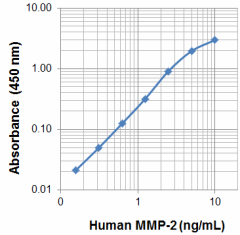- Clone
- M6303D01 (See other available formats)
- Regulatory Status
- RUO
- Other Names
- Matrix metallopeptidase 2, Gelatinase A, MMP-2, GelA, Clg4a, CLG4, MONA, TBE-1, MMP-II
- Isotype
- Mouse IgG1, κ
- Ave. Rating
- Submit a Review
- Product Citations
- publications

| Cat # | Size | Price | Quantity Check Availability | Save | ||
|---|---|---|---|---|---|---|
| 679902 | 100 µg | $229 | ||||
MMP-2, also known as gelatinase A, is a member the of matrix metalloproteinase family of proteins (MMPs). MMPs are structurally-related calcium-dependent, zinc-containing enzymes that degrade extracellular matrix and connective tissue proteins in normal physiological processes such as embryonic development, reproduction, and tissue remodeling. MMPs are also active in disease processes such as arthritis and metastasis.
MMP-2 consists of a pro-domain (cleaved upon activation), a catalytic domain containing the zinc binding site, a fibronectin-like domain (that plays a role in the substrate targeting), and a carboxyl-terminal hemopexin-like domain. The activated form of MMP-2 is produced by a 2-step proteolytic processing. First, a complex comprised of membrane type 1 MMP (MT1-MMP) and tissue inhibitor of metalloproteinase 2 (TIMP-2) recruits pro-MMP-2 from the extracellular milieu to the cell surface. The second step requires an active molecule of MT1-MMP, which itself activates MMP-2, leading to subsequent autocatalytic cleavage. Substrates of activated MMP-2 include several components of the articular cartilaginous matrix including: type IV collagen, aggrecan, link protein, decorin, fibronectin, and type X and XI collagens.
Elevated MMP-2 secretion is associated with poor prognosis in several types of human cancers. Mutations in the gene encoding MMP-2 gene are associated with Torg-Winchester syndrome, multicentric osteolysis, arthritis syndrome, and possibly keloids. MMP-2 deficient mice exhibit slightly delayed growth, reduced neovascularization, retarded tumor progression, an exaggerated asthma response to allergens, and impaired branching morphogenesis of the mammary glands.
Product DetailsProduct Details
- Verified Reactivity
- Human
- Antibody Type
- Monoclonal
- Host Species
- Mouse
- Immunogen
- Recombinant human MMP-2, amino acids (Ala30-Cys660) (Accession# NP_004521.1) with a C-terminal His tag and a linker sequence expressed in 293E cells.
- Formulation
- Phosphate-buffered solution, pH 7.2, containing 0.09% sodium azide.
- Preparation
- The antibody was purified by affinity chromatography.
- Concentration
- 0.5 mg/ml
- Storage & Handling
- The antibody solution should be stored undiluted between 2°C and 8°C.
- Application
-
ELISA Capture - Quality tested
- Recommended Usage
-
Each lot of this antibody is quality control tested by ELISA assay. For ELISA capture applications, a concentration of 2 µg/ml is recommended. To obtain a linear standard curve, serial dilutions of MMP-2 recombinant protein ranging from 10 to 0.156 ng/ml are recommended for each ELISA plate. It is recommended that the reagent be titrated for optimal performance for each application.
- Application Notes
-
ELISA Capture: The purified M6303D01 antibody is useful as the capture antibody in a sandwich ELISA assay, when used in conjunction with the biotinylated M6310C11 antibody (Cat. No. 532001) as the detecting antibody.
Note: For testing human MMP-2 in serum or plasma, BioLegend's LEGEND MAX™ Kits (Cat. No. 444607 & 444608) are specially developed and recommended.
- Product Citations
-
- RRID
-
AB_2566322 (BioLegend Cat. No. 679902)
Antigen Details
- Structure
- Monomer. Human MMP2 contains 660 amino acids with a predicted molecular weight of 73.9 kD. Upon activation by p-aminophenylmercuric acetate (APMA), it has a predicted molecular weight of 62 kD.
- Distribution
-
MMP2 is expressed by fibroblasts, endothelial cells, alveolar epithelial cells, and macrophages.
- Function
- MMP2 is a metalloproteinase that specifically cleaves type IV collagen, which is the major structural component of basement membranes. MMP2 is thought to contribute to the invasion and the metastasis of various human malignancies.
- Interaction
- Fibronectin, laminin, collagens III, IV, IX, and X, and cartilage proteoglycans, decorin, osteopontin, and IBP-3.
- Ligand/Receptor
- TIMPs, CLL7, and thrombospondin 1.
- Cell Type
- Endothelial cells, Epithelial cells, Fibroblasts, Macrophages
- Biology Area
- Angiogenesis, Cell Adhesion, Cell Biology, Neuroinflammation, Neuroscience
- Molecular Family
- Enzymes and Regulators
- Antigen References
-
1. Nagase H and Woessner JF. 1999. J. Biol. Chem. 274:21491.
2. Martignetti JA, et al. 2001. Nat. Genet. 28:261.
3. Itoh T, et al. 1997. J. Biol. Chem. 272:22389.
4. Passlick B, et al. 2000. Clin. Cancer Res. 6:3944.
5. Qian Q, et al. 2010. Cancer Invest. 28:661.
6. Hoikkala S, et al. 2006. Cancer Lett. 236:125.
7. Yamamura T, et al. 2002. Cancer 35:249. - Gene ID
- 4313 View all products for this Gene ID
- UniProt
- View information about MMP-2 on UniProt.org
Related Pages & Pathways
Pages
Other Formats
View All MMP-2 Reagents Request Custom Conjugation| Description | Clone | Applications |
|---|---|---|
| Purified anti-MMP2 | M6303D01 | ELISA Capture |
Compare Data Across All Formats
This data display is provided for general comparisons between formats.
Your actual data may vary due to variations in samples, target cells, instruments and their settings, staining conditions, and other factors.
If you need assistance with selecting the best format contact our expert technical support team.
 Login/Register
Login/Register 









Follow Us